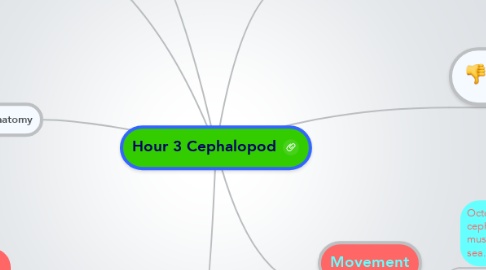Hour 3 Cephalopod
by Karla Lockman

1. Respiration
1.1. Cephalopods exchange gasses with the seawater. They force the water through their gills to exchange carbon dioxide for the oxygen in the new water brought in.
2. Anatomy
2.1. Cephalopods have tentacles.
2.2. Most cephalopod's tentacles are retractable.
2.3. Tentacles are used for capturing prey, while arms are mostly for movement.
2.4. Cephalopods have bilateral body symmetry
2.5. Nautilus have an external shell.
3. Reproduction/Life Cycle
3.1. cephalopods male makes an arm called a hectocotylus and transfers the sperm to the females pallial cavity. The female lays eggs and the eggs hach to a larva.
3.2. cephalopods reproduce by releasing a sperm sac in the females mantle cavity.
3.3. cephalopods reproduce by releasing a sperm sac in the females mantle cavity. cephalopods reproduce by releasing a sperm sac in the females mantle cavity.
4. Circulation
4.1. Cephalopods have a closed circulatory system. They also have 3 hearts, 2 bronchial hearts which pump unoxygenated blood to the gills and the 3rd ventricular heat that pumps oxygenated blood throughout the rest of the body.
5. Feeding/Digestion/Excretion
5.1. Cephalopods have tentacles, and most have beaks. Some use neurotoxins to paralyze their prey. All have a digestive cavity. They eat fish, shrimp, and other small critters.
6. Senses/Response
6.1. Octopus Sense/Response First sense is their vision, they have a polarized vision. Octopus arms have suction cup that are very tiny. They are high sensitive feelers that allow them to touch their enviroment
6.2. Cephaloped: they can smell their prey from far away.
7. Movement
7.1. Octopus have a different way of moving then all other cephalopods. They crawl across the ocean floor. They use their muscular arms and suckers to anchor them to the bottom of the sea.
7.2. Cuttlefish, squid and nautilus move by bringing water into their body cavity and then expelling it out sending them forward. (Jet propulsion)


